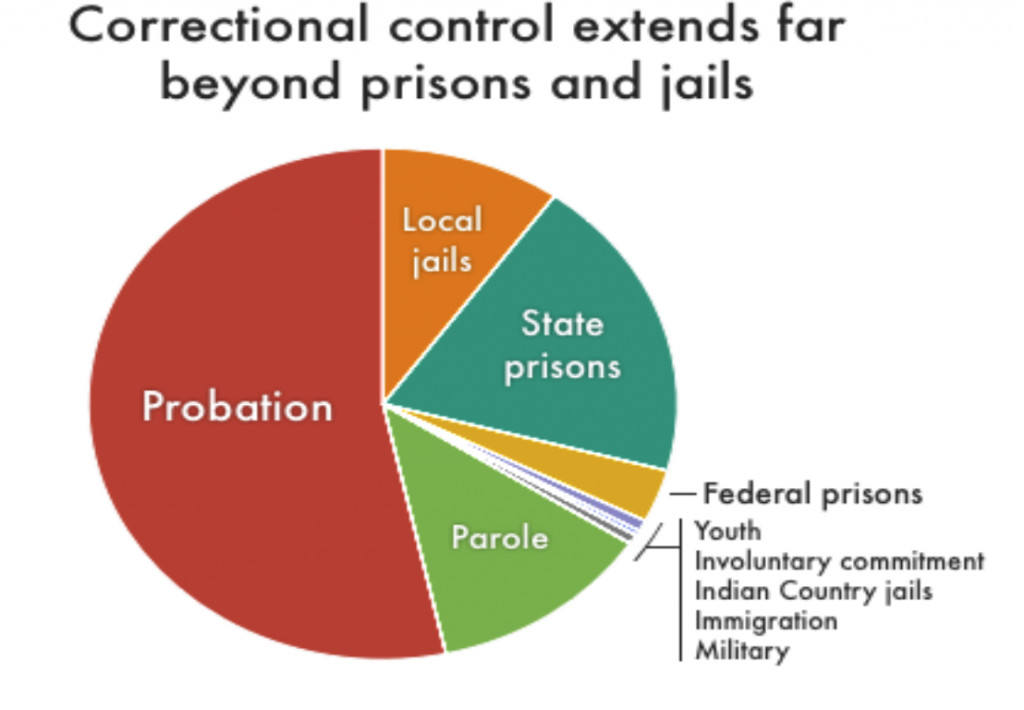9.2. Intermediate Sanctions
David Carter
Community corrections as a whole have changed dramatically over the last half-century. Due to a rapid and overwhelming increase in the offender population, largely based on policy changes, we have witnessed an immense increase in the use of sanctions at the community level; this includes probation. It has only been within the most recent 10 years that we have seen a decrease in community corrections. Individuals on probation hover around 3.7 million, with another million in some form of community-level control, for a total of about 4.6 million under community supervision, probation, or parole. [1] Because of the sheer volume of these intermediate sanctions, it is important to put it in the perspective of jails and prisons. Below is a graphic to demonstrate how much we are talking about.
U.S. Correctional Control

This graphic does not include the volume of people in the community corrections outside of regular probation, or parole (which is about another million), but it does shed light on just how much probation is used. Therefore, it is important to understand that the vast majority of individuals under correctional control aren’t even in the prisons and jails in the United States, even though that alone is a hefty number. The majority of persons under correctional control fall into sanctions like Probation, Intensive Supervision Probation, Boot Camps/Shock Incarceration, Drug Courts, and Halfway Houses. Therefore, this section will discuss the history and effectiveness of some of the forms of intermediate sanctions we use in the United States.
As we have discussed, in the late 1970s and early 1980s, there was a fundamental shift in corrections. This is largely due to the “Nothing Works” dogma in the area of rehabilitation. Many reforms were made towards the housing of offenders. Many liked this idea because they did not trust the government’s attempts at rehabilitation. Others were pleased as well since more emphasis was placed on control. Rooted in deterrence theory, and to a lesser extent incapacitation, intermediate sanctions flourished and were seen as an instant success. That is, because they promised to increase control of the growing offender population, maintain security, and do all of this at a reduced cost, they were quickly welcomed across the nation. However, by reviewing each one, we can see the problems that promising too much may have created.
What Would You Do?
As stated before, there are three primary goals for corrections, to punish the offender, to protect society, and to rehabilitate the offender. Often the first two goals might be opposing to the last goal. Additionally, doing too much of the first one might have unfavorable on the second and third. Here is an example of how this might happen.
Let’s say there is a guy, who is married, has a couple of kids, a stable blue-collar job, a house /mortgage, and is living just a little bit better than paycheck to paycheck. We can call him the average Joe Citizen. This might even sound familiar, and you may even know him. Joe likes to hang out with his friends after his men’s softball game, have a beer, and catch up on life. Joe is a decent guy. He does not have a significant criminal record. Perhaps one misdemeanor when he was a juvenile, and a couple of speeding tickets, like tens of millions of other adults.
However, one time after softball, Joe is driving home and his wife is texting him to pick something up at the store. He looks down at his phone at the exact wrong time that someone pulls out in front of him. An accident occurs. No one is seriously injured, but the damage to both vehicles is enough to warrant a write-up of the accident. This leads to police presence. At the scene, the officer smells alcohol on Joe. The officer is obligated to go through standard procedures, which results in Joe being arrested. This is not asking you to debate this action, as it is a violation, and the officer had every right to arrest Joe. The question is this – what should Joe’s punishment be?
The reason to ask this is due to both the rule of law and the consequences of those laws. Joe should be punished, as he chose to drive after drinking alcohol. But, would Joe’s incarceration lead to other events that may have lasting effects? Probably.
This brings up the question of at what point the level of punishment lasts beyond its intended point. If Joe receives a lengthy jail sentence, will he lose his job? Will he lose his family? Will this put him at a greater risk of recidivating in the future? At what point has the immediate action caused punishment beyond what the law stipulates is punishment? These are all valid questions. There are other alternatives out there, that still cover the concepts of punishment, monitoring, sanctioning, and control. However, these alternatives can still allow individuals to stay in the community, which this chapter will present with community corrections.
- Bureau of Justice Statistics. (2018). Probation and Parole in the United States, 2016. Available at: https://www.bjs.gov/content/pub/pdf/ppus16_sum.pdf ↵

